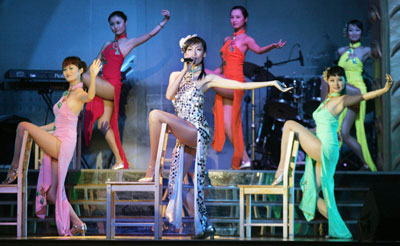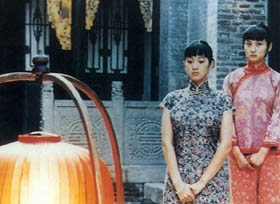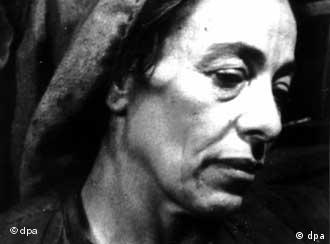 And then there are the poems written in English...I'm not sure where the poems from the Nuyorican anthology would fit, and I forget whether Michael Ondatjee wrote his poems in English or another language.
And then there are the poems written in English...I'm not sure where the poems from the Nuyorican anthology would fit, and I forget whether Michael Ondatjee wrote his poems in English or another language.We began our unit on poetry, discussing some Romantic poets and their poems (excerpts from Lord Byron's mock-epic Don Juan, Coleridge's "Rime of the Ancient Mariner," and Keats' beautiful "Eve of St. Agnes"--the image above is Holman Hunt's painting of a scene from that poem). In the section of "Don Juan" that we read, Juan has landed on an island where he and Haidee, the daughter of a pirate king, will fall in love. Juan is no innocent as he is escaping from his (discovered) affair with an older woman. Byron plays with the conventions of the epic, especially as he goes off track, discoursing on "wine and women, mirth and laughter." We also discussed Coleridge and Keats' narrative poems. Although I did not mention it that day, the concept of medievalism is important here.
We moved onto Walt Whitman's poetry from Leaves of Grass, a collection that he revised throughout his adult life (Whitman lived from 1819 to 1892). Two poems that we looked at were "I Hear America Singing," for its inclusiveness (that Ruben Dario later plays on) and "O Captain! My Captain," a more conventional eulogy to Abraham Lincoln. We discussed whether or not these poems could be sung with accompaniment. (We had just watched the tape of Coleman Barks' performance.) "O Captain! My Captain!" also seems like it would be easy to memorize!
For a contrast, later, we looked at poems by Native American writers Paula Gunn Allen and Leslie Marmon Silko. These seemed to be harder to read, and it became harder for us to say what was poetic about them. These poems were Gunn Allen's "Pocahontas, to her English Husband, John Rolfe" and the ironic "Taking a Visitor to See the Ruins" (about the poet's taking a guest to see her mother and her grandmother at their high rise apartment) as well as Marmon Silko's excerpt from The Storyteller in which she retells a Coyote tale told by her white great-grand father. This time Coyote is not a male trickster but a female victim of another figure's trickery, and her pups die of thirst because of this trickery. As I reflect on these poems, I remember Ngugi wa Thiong'o's essay on the importance of writing African literature in African (i.e., native) languages. Should Leslie Marmon Silko or Paula Gunn Allen write their poems in Keresan (the language of the Laguna Pueblo)?
Mary also brought in some of Billy Collins' poems as well as reading one of her own. (Her poem, by the way, is in the Advocate. Congratulations!!)
We also looked at the relationship of poetry and music/popular song, figuring in the concept of orality and the effect of print culture. Songs that we listened to included three from Richard Thompson's 1000 Years of Popular Music (the medieval "Sumer is Icumen In" [also parodied by Ezra Pound at one point], the 18th century ballad "Bonnie St. Johnstone," and a cover of Britney Spears' "Oops..."). Here are links to the lyrics of the first two songs:
http://www.richardthompson-music.com/song_o_matic.asp?id=428
http://www.richardthompson-music.com/song_o_matic.asp?id=586
We also listened to English-language and Spanish-language songs by Los Lobos. Here is a link to the lyrics of the English-language song, "One Time, One Night" from 1987:
http://www.lyricsmania.com/lyrics/los_lobos_lyrics_5296/by_the_light_of_the_moon_lyrics_16979/one_time_one_night_lyrics_196225.html
These are the Spanish lyrics of their version of "Volver, Volver":
http://www.lyricsdir.com/los-lobos-volver-volver-lyrics.html
We also listened to songs by The Mighty Sparrow, a famous calypso singer from Trinidad. Is he a trickster or an acute social observer?
Here is Billboard.com's catalog entry for Early Flight, the album that I brought in. (We listened to "Sailor Man," "Dear Sparrow," and "Russian Satellite.")
http://www.billboard.com/bbcom/discography/index.jsp?JSESSIONID=DK1KH51JV1XMm1zXTgqTHdYFLnWy1bXQPTmY9b4pm0hdvLTzxy1d!87636624&pid=3875&aid=742126
I will let you look for his videos on YouTube! Good night!








 As much as I love this picture, I need to put up some text.
As much as I love this picture, I need to put up some text. 
 Above is a scene from the 1986 TV version of The Story of a Stone or The Dream of the Red Chamber. The character above is Bao-yu's beloved (and cousin), Lin-yu.
Above is a scene from the 1986 TV version of The Story of a Stone or The Dream of the Red Chamber. The character above is Bao-yu's beloved (and cousin), Lin-yu.
 Before the midterm, we watched some films that were based on English-language novels. These films included Apocalypse Now, the 1944 Jane Eyre starring Orson Welles, and the 1999 David Copperfield with a very young Daniel Radcliffe. (Note: the version of David Copperfield that we saw was a TV miniseries and not intended for theatrical release.) However, English-language novels are not the only literary sources that filmmakers draw on!
Before the midterm, we watched some films that were based on English-language novels. These films included Apocalypse Now, the 1944 Jane Eyre starring Orson Welles, and the 1999 David Copperfield with a very young Daniel Radcliffe. (Note: the version of David Copperfield that we saw was a TV miniseries and not intended for theatrical release.) However, English-language novels are not the only literary sources that filmmakers draw on! This study guide for drama & theater will cover A Doll's House, Mother Courage, and The Love Suicides at Amijima. The Taming of the Shrew will be included in our film unit. The Japanese play Shintoku-Maru and August Wilson's Gem of the Ocean will not be included on the final--unless you'd like to mention them in the extra credit section!
This study guide for drama & theater will cover A Doll's House, Mother Courage, and The Love Suicides at Amijima. The Taming of the Shrew will be included in our film unit. The Japanese play Shintoku-Maru and August Wilson's Gem of the Ocean will not be included on the final--unless you'd like to mention them in the extra credit section! 


 Below is a picture of images from Kabuki theater:
Below is a picture of images from Kabuki theater:


 This photo from Syracuse Stage's 2007 production of August Wilson's Gem of the Ocean is very striking, but I thought I'd put up some words this evening to go with it. Also, I'd like to find a few good pictures as well.
This photo from Syracuse Stage's 2007 production of August Wilson's Gem of the Ocean is very striking, but I thought I'd put up some words this evening to go with it. Also, I'd like to find a few good pictures as well.
 However, as Gem of the Ocean contains much magic realism, a museum-quality set might be inappropriate. After all, Citizen Barlow travels to the City of Bones in a paper boat made from Aunt Ester's bill of sale, and the play's most prosaic character, Caesar, is clearly an interloper.
However, as Gem of the Ocean contains much magic realism, a museum-quality set might be inappropriate. After all, Citizen Barlow travels to the City of Bones in a paper boat made from Aunt Ester's bill of sale, and the play's most prosaic character, Caesar, is clearly an interloper.



